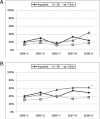The burden of influenza in young children, 2004-2009
- PMID: 23296444
- PMCID: PMC3557405
- DOI: 10.1542/peds.2012-1255
The burden of influenza in young children, 2004-2009
Abstract
Objective: To characterize the health care burden of influenza from 2004 through 2009, years when influenza vaccine recommendations were expanded to all children aged ≥6 months.
Methods: Population-based surveillance for laboratory-confirmed influenza was performed among children aged <5 years presenting with fever and/or acute respiratory illness to inpatient and outpatient settings during 5 influenza seasons in 3 US counties. Enrolled children had nasal/throat swabs tested for influenza by reverse transcriptase-polymerase chain reaction and their medical records reviewed. Rates of influenza hospitalizations per 1000 population and proportions of outpatients (emergency department and clinic) with influenza were computed.
Results: The study population comprised 2970, 2698, and 2920 children from inpatient, emergency department, and clinic settings, respectively. The single-season influenza hospitalization rates were 0.4 to 1.0 per 1000 children aged <5 years and highest for infants <6 months. The proportion of outpatient children with influenza ranged from 10% to 25% annually. Among children hospitalized with influenza, 58% had physician-ordered influenza testing, 35% had discharge diagnoses of influenza, and 2% received antiviral medication. Among outpatients with influenza, 7% were tested for influenza, 7% were diagnosed with influenza, and <1% had antiviral treatment. Throughout the 5 study seasons, <45% of influenza-negative children ≥6 months were fully vaccinated against influenza.
Conclusions: Despite expanded vaccination recommendations, many children are insufficiently vaccinated, and substantial influenza burden remains. Antiviral use was low. Future studies need to evaluate trends in use of vaccine and antiviral agents and their impact on disease burden and identify strategies to prevent influenza in young infants.
Figures




Similar articles
-
Burden of severe illness associated with laboratory confirmed influenza in adults aged 50-64 years: A rapid review.Influenza Other Respir Viruses. 2022 Jul;16(4):632-642. doi: 10.1111/irv.12955. Epub 2022 Jan 19. Influenza Other Respir Viruses. 2022. PMID: 35044096 Free PMC article. Review.
-
Influenza vaccine effectiveness among children 6 to 59 months of age during 2 influenza seasons: a case-cohort study.Arch Pediatr Adolesc Med. 2008 Oct;162(10):943-51. doi: 10.1001/archpedi.162.10.943. Arch Pediatr Adolesc Med. 2008. PMID: 18838647
-
Patterns of Influenza Vaccination and Vaccine Effectiveness Among Young US Children Who Receive Outpatient Care for Acute Respiratory Tract Illness.JAMA Pediatr. 2020 Jul 1;174(7):705-713. doi: 10.1001/jamapediatrics.2020.0372. JAMA Pediatr. 2020. PMID: 32364599 Free PMC article.
-
The population impact of a large school-based influenza vaccination campaign.PLoS One. 2010 Nov 30;5(11):e15097. doi: 10.1371/journal.pone.0015097. PLoS One. 2010. PMID: 21209872 Free PMC article.
-
Global Role and Burden of Influenza in Pediatric Respiratory Hospitalizations, 1982-2012: A Systematic Analysis.PLoS Med. 2016 Mar 24;13(3):e1001977. doi: 10.1371/journal.pmed.1001977. eCollection 2016 Mar. PLoS Med. 2016. PMID: 27011229 Free PMC article. Review.
Cited by
-
Respiratory Virus Surveillance Among Children with Acute Respiratory Illnesses - New Vaccine Surveillance Network, United States, 2016-2021.MMWR Morb Mortal Wkly Rep. 2022 Oct 7;71(40):1253-1259. doi: 10.15585/mmwr.mm7140a1. MMWR Morb Mortal Wkly Rep. 2022. PMID: 36201373 Free PMC article.
-
Burden of severe illness associated with laboratory confirmed influenza in adults aged 50-64 years: A rapid review.Influenza Other Respir Viruses. 2022 Jul;16(4):632-642. doi: 10.1111/irv.12955. Epub 2022 Jan 19. Influenza Other Respir Viruses. 2022. PMID: 35044096 Free PMC article. Review.
-
A 10-year-old female with unilateral seventh cranial nerve palsy.Paediatr Child Health. 2019 May;24(2):69-71. doi: 10.1093/pch/pxy069. Epub 2018 May 30. Paediatr Child Health. 2019. PMID: 30996593 Free PMC article. No abstract available.
-
Timing of First Respiratory Virus Detections in Infants: A Community-Based Birth Cohort Study.J Infect Dis. 2018 Jan 17;217(3):418-427. doi: 10.1093/infdis/jix599. J Infect Dis. 2018. PMID: 29165576 Free PMC article.
-
Influenza Vaccination Coverage in Children: How Has COVID-19 Influenced It? A Review of Five Seasons (2018-2023) in Central Catalonia, Spain.Vaccines (Basel). 2024 Aug 18;12(8):925. doi: 10.3390/vaccines12080925. Vaccines (Basel). 2024. PMID: 39204048 Free PMC article.
References
-
- Harper SA, Fukuda K, Uyeki TM, Cox NJ, Bridges CB, Centers for Disease Control and Prevention (CDC) Advisory Committee on Immunization Practices (ACIP) . Prevention and control of influenza: recommendations of the Advisory Committee on Immunization Practices (ACIP). MMWR Recomm Rep. 2004;53(RR-6):1–40 - PubMed
-
- Smith NM, Bresee JS, Shay DK, Uyeki TM, Cox NJ, Strikas RA, Advisory Committee on Immunization Practices . Prevention and control of influenza: recommendations of the Advisory Committee on Immunization Practices (ACIP). MMWR Recomm Rep. 2006;55(RR-10):1–42 - PubMed
-
- Fiore AE, Shay DK, Broder K, et al. Centers for Disease Control and Prevention (CDC) Advisory Committee on Immunization Practices (ACIP) . Prevention and control of influenza: recommendations of the Advisory Committee on Immunization Practices (ACIP), 2008. MMWR Recomm Rep. 2008;57(RR-7):1–60 - PubMed
-
- Poehling KA, Edwards KM, Weinberg GA, et al. New Vaccine Surveillance Network . The underrecognized burden of influenza in young children. N Engl J Med. 2006;355(1):31–40 - PubMed
-
- Staat MA, Griffin MR, Donauer S, et al. . Vaccine effectiveness for laboratory-confirmed influenza in children 6–59 months of age, 2005–2007. Vaccine. 2011;29(48):9005–9011 - PubMed
Publication types
MeSH terms
Substances
Grants and funding
LinkOut - more resources
Full Text Sources
Other Literature Sources
Medical

